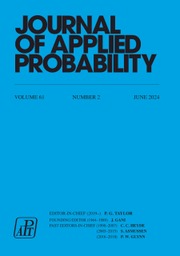No CrossRef data available.
Article contents
A bound for bivariate probability of large deviations
Published online by Cambridge University Press: 14 July 2016
Abstract
Suppose (X 1, Y 1), (X 2, Y 2), …, (Xn , Yn ) are independent random vectors such that a ≦ Xi ≦ b and a ≦ Yi ≦ b, i = 1, 2, …, n. An upper bound which exponentially converges to zero is derived for the probability Pr{Sx – nμ x ≧ nt 1;SY – nμY ≧ nt 2} where Sx = Σ Xi , SY = Σ Yi ,EYi = μY, EXi = μx and t 1 > 0, t2 > 0. The bound is a function of the difference b — a, the correlation between Xi and Yi, μx and μY and t 1 and t 2 .
Information
- Type
- Short Communications
- Information
- Copyright
- Copyright © Applied Probability Trust 1976
References
[1]
Agnew, R. A. (1972) Inequalities with application to economic risk analysis.
J. Appl. Prob.
9, 441–444.Google Scholar
[2]
Ben-Tal, A. and Hochman, E. (1972) More bounds on the expectation of a convex function of a random variable.
J. Appl. Prob.
9, 803–812.Google Scholar
[3]
Bernstein, S. N. (1924) Sur une modification de l'inequalité de Tchebichef.
Ann. Sci. Inst. Math. Sav. Ukraine Ser. 3
1, 1–15.Google Scholar
[4]
Brook, D. (1966) Bounds for moment generating functions and for extinction probabilities.
J. Appl. Prob.
3, 171–178.Google Scholar
[5]
Hoeffding, W. (1963) Probability inequalities for sums of bounded random variables,
J. Amer. Statist. Assoc.
58, 13–30.Google Scholar
[6]
Mullen, K. (1973) Bernstein's inequality in the bivariate case.
Canad. Math. Bull.
16, 83–86.CrossRefGoogle Scholar

